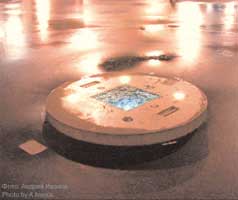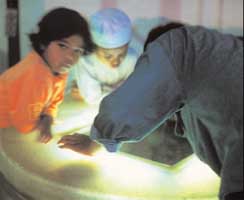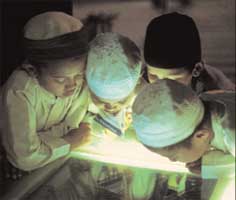See and hear through the earth, or the thirtieth kingdom on-line
Of course, the holes are holes. For example, through the “hole” Alice fell “Through the Looking Glass” to the “antipodes”. This event was not sad, but, on the contrary, entertaining. Something like these “holes” for contemplating “antipodes” was created by a graduate of the environmental information department of the Tokyo University of Keio. Maki Ueda became famous for inventing a virtual tunnel that connected the polar points of the planet.  The ends of the “tunnel” are symmetrical installations, equipped with plasma screens, on which what is happening at the opposite end of the Earth is transmitted around the clock using satellite communications. Thanks to the microphones, you not only see, but also hear the euphoric exclamations of the “antipodes” falling to the screen in distant lands. A waterproof screen with anti-vandal glass, mounted in a steel box, gives the impression of a magic well, in which, like through the water, there are unclear figures and faces of fellows of a different skin color.
The ends of the “tunnel” are symmetrical installations, equipped with plasma screens, on which what is happening at the opposite end of the Earth is transmitted around the clock using satellite communications. Thanks to the microphones, you not only see, but also hear the euphoric exclamations of the “antipodes” falling to the screen in distant lands. A waterproof screen with anti-vandal glass, mounted in a steel box, gives the impression of a magic well, in which, like through the water, there are unclear figures and faces of fellows of a different skin color.  The first "tunnel" connected residents of Rotterdam and Shanghai in 2001, and in 2004 - Rotterdam and the Muslim town of Bandung (Indonesia). The Dutch installation is likened to a water supply hatch raised above the ground. The Hole in the Earth project is conceived as an on-line action, constantly updating information resources and encouraging designers to prepare for the “laying” of new “tunnels”.
The first "tunnel" connected residents of Rotterdam and Shanghai in 2001, and in 2004 - Rotterdam and the Muslim town of Bandung (Indonesia). The Dutch installation is likened to a water supply hatch raised above the ground. The Hole in the Earth project is conceived as an on-line action, constantly updating information resources and encouraging designers to prepare for the “laying” of new “tunnels”. 
 The designer associated the effect of her discovery with the impression that the first telephone connection produced. At one time, subscribers at a distance of several thousand kilometers were thrown by meaningless household phrases that adapted them to the sensation of a spatial chasm, and now participants in the international dialogue are costing interjections and gesticulating violently, experiencing a feeling of unity. , made on the moon by the crew of Apollo 11 and became the first visual proof of the spherical shape of the planet. She explained the ambitious project by attempting to visualize the possibilities of the Internet, as if denying space and time. The project is inspired by an attempt to bring together the polar civilizations that characterize the process of socio-cultural globalization that has swept the world, despite sharp political conflicts. Magazine: Architectural Gazette
The designer associated the effect of her discovery with the impression that the first telephone connection produced. At one time, subscribers at a distance of several thousand kilometers were thrown by meaningless household phrases that adapted them to the sensation of a spatial chasm, and now participants in the international dialogue are costing interjections and gesticulating violently, experiencing a feeling of unity. , made on the moon by the crew of Apollo 11 and became the first visual proof of the spherical shape of the planet. She explained the ambitious project by attempting to visualize the possibilities of the Internet, as if denying space and time. The project is inspired by an attempt to bring together the polar civilizations that characterize the process of socio-cultural globalization that has swept the world, despite sharp political conflicts. Magazine: Architectural Gazette
 The ends of the “tunnel” are symmetrical installations, equipped with plasma screens, on which what is happening at the opposite end of the Earth is transmitted around the clock using satellite communications. Thanks to the microphones, you not only see, but also hear the euphoric exclamations of the “antipodes” falling to the screen in distant lands. A waterproof screen with anti-vandal glass, mounted in a steel box, gives the impression of a magic well, in which, like through the water, there are unclear figures and faces of fellows of a different skin color.
The ends of the “tunnel” are symmetrical installations, equipped with plasma screens, on which what is happening at the opposite end of the Earth is transmitted around the clock using satellite communications. Thanks to the microphones, you not only see, but also hear the euphoric exclamations of the “antipodes” falling to the screen in distant lands. A waterproof screen with anti-vandal glass, mounted in a steel box, gives the impression of a magic well, in which, like through the water, there are unclear figures and faces of fellows of a different skin color.  The first "tunnel" connected residents of Rotterdam and Shanghai in 2001, and in 2004 - Rotterdam and the Muslim town of Bandung (Indonesia). The Dutch installation is likened to a water supply hatch raised above the ground. The Hole in the Earth project is conceived as an on-line action, constantly updating information resources and encouraging designers to prepare for the “laying” of new “tunnels”.
The first "tunnel" connected residents of Rotterdam and Shanghai in 2001, and in 2004 - Rotterdam and the Muslim town of Bandung (Indonesia). The Dutch installation is likened to a water supply hatch raised above the ground. The Hole in the Earth project is conceived as an on-line action, constantly updating information resources and encouraging designers to prepare for the “laying” of new “tunnels”. 
 The designer associated the effect of her discovery with the impression that the first telephone connection produced. At one time, subscribers at a distance of several thousand kilometers were thrown by meaningless household phrases that adapted them to the sensation of a spatial chasm, and now participants in the international dialogue are costing interjections and gesticulating violently, experiencing a feeling of unity. , made on the moon by the crew of Apollo 11 and became the first visual proof of the spherical shape of the planet. She explained the ambitious project by attempting to visualize the possibilities of the Internet, as if denying space and time. The project is inspired by an attempt to bring together the polar civilizations that characterize the process of socio-cultural globalization that has swept the world, despite sharp political conflicts. Magazine: Architectural Gazette
The designer associated the effect of her discovery with the impression that the first telephone connection produced. At one time, subscribers at a distance of several thousand kilometers were thrown by meaningless household phrases that adapted them to the sensation of a spatial chasm, and now participants in the international dialogue are costing interjections and gesticulating violently, experiencing a feeling of unity. , made on the moon by the crew of Apollo 11 and became the first visual proof of the spherical shape of the planet. She explained the ambitious project by attempting to visualize the possibilities of the Internet, as if denying space and time. The project is inspired by an attempt to bring together the polar civilizations that characterize the process of socio-cultural globalization that has swept the world, despite sharp political conflicts. Magazine: Architectural Gazette')
Source: https://habr.com/ru/post/8764/
All Articles